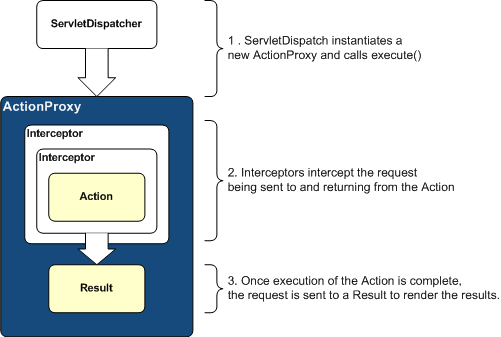接下来,我们将重点讨论一下Struts2中的拦截器的内部结构和执行顺序,并结合源码进行分析。
Interceptor结构

图中,我们可以发现,Struts2的Interceptor一层一层,把Action包裹在最里面。这样的结构,大概有以下一些特点:
1. 整个结构就如同一个堆栈,除了Action以外,堆栈中的其他元素是Interceptor
2. Action位于堆栈的底部。由于堆栈"先进后出"的特性,如果我们试图把Action拿出来执行,我们必须首先把位于Action上端的Interceptor拿出来执行。这样,整个执行就形成了一个递归调用
3. 每个位于堆栈中的Interceptor,除了需要完成它自身的逻辑,还需要完成一个特殊的执行职责。这个执行职责有3种选择:
1) 中止整个执行,直接返回一个字符串作为resultCode
2) 通过递归调用负责调用堆栈中下一个Interceptor的执行 (invocation.invoke())
3) 如果在堆栈内已经不存在任何的Interceptor,调用Action
Struts2的拦截器结构的设计,实际上是一个典型的责任链模式的应用。首先将整个执行划分成若干相同类型的元素,每个元素具备不同的逻辑责任,并将他们纳入到一个链式的数据结构中(我们可以把堆栈结构也看作是一个递归的链式结构),而每个元素又有责任负责链式结构中下一个元素的执行调用。
这样的设计,从代码重构的角度来看,实际上是将一个复杂的系统,分而治之,从而使得每个部分的逻辑能够高度重用并具备高度可扩展性。所以,Interceptor结构实在是Struts2/Xwork设计中的精华之笔。
Interceptor执行分析
我们来看一下Interceptor的接口的定义:
- public interface Interceptor extends Serializable {
- /**
- * Called to let an interceptor clean up any resources it has allocated.
- */
- void destroy();
- /**
- * Called after an interceptor is created, but before any requests are processed using
- * {@link #intercept(com.opensymphony.xwork2.ActionInvocation) intercept} , giving
- * the Interceptor a chance to initialize any needed resources.
- */
- void init();
- /**
- * Allows the Interceptor to do some processing on the request before and/or after the rest of the processing of the
- * request by the {@link ActionInvocation} or to short-circuit the processing and just return a String return code.
- *
- * @return the return code, either returned from {@link ActionInvocation#invoke()}, or from the interceptor itself.
- * @throws Exception any system-level error, as defined in {@link com.opensymphony.xwork2.Action#execute()}.
- */
- String intercept(ActionInvocation invocation) throws Exception;
- }
Interceptor的接口定义没有什么特别的地方,除了init和destory方法以外,intercept方法是实现整个拦截器机制的核心方法。而它所依赖的参数ActionInvocation则是我们之前章节中曾经提到过的著名的Action调度者。
我们再来看看一个典型的Interceptor的抽象实现类:
- public abstract class AroundInterceptor extends AbstractInterceptor {
- /* (non-Javadoc)
- * @see com.opensymphony.xwork2.interceptor.AbstractInterceptor#intercept(com.opensymphony.xwork2.ActionInvocation)
- */
- @Override
- public String intercept(ActionInvocation invocation) throws Exception {
- String result = null;
- before(invocation);
- // 调用下一个拦截器,如果拦截器不存在,则执行Action
- result = invocation.invoke();
- after(invocation, result);
- return result;
- }
- public abstract void before(ActionInvocation invocation) throws Exception;
- public abstract void after(ActionInvocation invocation, String resultCode) throws Exception;
- }
在这个实现类中,实际上已经实现了最简单的拦截器的雏形。或许大家对这样的代码还比较陌生,这没有关系。我在这里需要指出的是一个很重要的方法invocation.invoke()。这是ActionInvocation中的方法,而ActionInvocation是Action调度者,所以这个方法具备以下2层含义:
1. 如果拦截器堆栈中还有其他的Interceptor,那么invocation.invoke()将调用堆栈中下一个Interceptor的执行。
2. 如果拦截器堆栈中只有Action了,那么invocation.invoke()将调用Action执行。
所以,我们可以发现,invocation.invoke()这个方法其实是整个拦截器框架的实现核心。基于这样的实现机制,我们还可以得到下面2个非常重要的推论:
1. 如果在拦截器中,我们不使用invocation.invoke()来完成堆栈中下一个元素的调用,而是直接返回一个字符串作为执行结果,那么整个执行将被中止。
2. 我们可以以invocation.invoke()为界,将拦截器中的代码分成2个部分,在invocation.invoke()之前的代码,将会在Action之前被依次执行,而在invocation.invoke()之后的代码,将会在Action之后被逆序执行。
由此,我们就可以通过invocation.invoke()作为Action代码真正的拦截点,从而实现AOP。
Interceptor拦截类型
从上面的分析,我们知道,整个拦截器的核心部分是invocation.invoke()这个函数的调用位置。事实上,我们也正式根据这句代码的调用位置,来进行拦截类型的区分的。在Struts2中,Interceptor的拦截类型,分成以下三类:
1. before
before拦截,是指在拦截器中定义的代码,它们存在于invocation.invoke()代码执行之前。这些代码,将依照拦截器定义的顺序,顺序执行。
2. after
after拦截,是指在拦截器中定义的代码,它们存在于invocation.invoke()代码执行之后。这些代码,将一招拦截器定义的顺序,逆序执行。
3. PreResultListener
有的时候,before拦截和after拦截对我们来说是不够的,因为我们需要在Action执行完之后,但是还没有回到视图层之前,做一些事情。Struts2同样支持这样的拦截,这种拦截方式,是通过在拦截器中注册一个PreResultListener的接口来实现的。
- public interface PreResultListener {
- /**
- * This callback method will be called after the Action execution and before the Result execution.
- *
- * @param invocation
- * @param resultCode
- */
- void beforeResult(ActionInvocation invocation, String resultCode);
- }
在这里,我们看到,Struts2能够支持如此多的拦截类型,与其本身的数据结构和整体设计有很大的关系。正如我在之前的文章中所提到的:
我们可以看到,Struts2对于整个执行的划分,从Interceptor到Action一直到Result,每一层都职责明确。不仅如此,Struts2还为每一个层次之前都设立了恰如其分的插入点。使得整个Action层的扩展性得到了史无前例的提升。
Interceptor执行顺序
Interceptor的执行顺序或许是我们在整个过程中最最关心的部分。根据上面所提到的概念,我们实际上已经能够大致明白了Interceptor的执行机理。我们来看看Struts2的Reference对Interceptor执行顺序的一个形象的例子。
如果我们有一个interceptor-stack的定义如下:
- <interceptor-stack name="xaStack">
- <interceptor-ref name="thisWillRunFirstInterceptor"/>
- <interceptor-ref name="thisWillRunNextInterceptor"/>
- <interceptor-ref name="followedByThisInterceptor"/>
- <interceptor-ref name="thisWillRunLastInterceptor"/>
- </interceptor-stack>
那么,整个执行的顺序大概像这样:

在这里,我稍微改了一下Struts2的Reference中的执行顺序示例,使得整个执行顺序更加能够被理解。我们可以看到,递归调用保证了各种各样的拦截类型的执行能够井井有条。
请注意在这里,每个拦截器中的代码的执行顺序,在Action之前,拦截器的执行顺序与堆栈中定义的一致;而在Action和Result之后,拦截器的执行顺序与堆栈中定义的顺序相反。
源码解析
之前我曾经提到,ActionInvocation是Struts2中的调度器,所以事实上,这些代码的调度执行,是在ActionInvocation的实现类中完成的,这里,我抽取了DefaultActionInvocation中的invoke()方法,它将向我们展示一切。
- /**
- * @throws ConfigurationException If no result can be found with the returned code
- */
- public String invoke() throws Exception {
- String profileKey = "invoke: ";
- try {
- UtilTimerStack.push(profileKey);
- if (executed) {
- throw new IllegalStateException("Action has already executed");
- }
- // 依次调用拦截器堆栈中的拦截器代码执行
- if (interceptors.hasNext()) {
- final InterceptorMapping interceptor = (InterceptorMapping) interceptors.next();
- UtilTimerStack.profile("interceptor: "+interceptor.getName(),
- new UtilTimerStack.ProfilingBlock<String>() {
- public String doProfiling() throws Exception {
- // 将ActionInvocation作为参数,调用interceptor中的intercept方法执行
- resultCode = interceptor.getInterceptor().intercept(DefaultActionInvocation.this);
- return null;
- }
- });
- } else {
- resultCode = invokeActionOnly();
- }
- // this is needed because the result will be executed, then control will return to the Interceptor, which will
- // return above and flow through again
- if (!executed) {
- // 执行PreResultListener
- if (preResultListeners != null) {
- for (Iterator iterator = preResultListeners.iterator();
- iterator.hasNext();) {
- PreResultListener listener = (PreResultListener) iterator.next();
- String _profileKey="preResultListener: ";
- try {
- UtilTimerStack.push(_profileKey);
- listener.beforeResult(this, resultCode);
- }
- finally {
- UtilTimerStack.pop(_profileKey);
- }
- }
- }
- // now execute the result, if we're supposed to
- // action与interceptor执行完毕,执行Result
- if (proxy.getExecuteResult()) {
- executeResult();
- }
- executed = true;
- }
- return resultCode;
- }
- finally {
- UtilTimerStack.pop(profileKey);
- }
- }
从源码中,我们可以看到,我们之前提到的Struts2的Action层的4个不同的层次,在这个方法中都有体现,他们分别是:拦截器(Interceptor)、Action、PreResultListener和Result。在这个方法中,保证了这些层次的有序调用和执行。由此我们也可以看出Struts2在Action层次设计上的众多考虑,每个层次都具备了高度的扩展性和插入点,使得程序员可以在任何喜欢的层次加入自己的实现机制改变Action的行为。
在这里,需要特别强调的,是其中拦截器部分的执行调用:
- resultCode = interceptor.getInterceptor().intercept(DefaultActionInvocation.this);
- public String intercept(ActionInvocation invocation) throws Exception {
- String result = null;
- before(invocation);
- // 调用invocation的invoke()方法,在这里形成了递归调用 ,执行下一个拦截器或antion
- result = invocation.invoke();
- after(invocation, result);
- return result;
- }
原来在intercept()方法又对ActionInvocation的invoke()方法进行递归调用,ActionInvocation循环嵌套在intercept()中,一直到语句result = invocation.invoke()执行结束。这样,Interceptor又会按照刚开始执行的逆向顺序依次执行结束。
一个有序链表,通过递归调用,变成了一个堆栈执行过程,将一段有序执行的代码变成了2段执行顺序完全相反的代码过程,从而巧妙地实现了AOP。这也就成为了Struts2的Action层的AOP基础。
|
拦截器 |
名字 |
说明 |
|
Alias Interceptor |
alias |
在不同请求之间将请求参数在不同名字件转换,请求内容不变 |
|
Chaining Interceptor |
chain |
让前一个Action的属性可以被后一个Action访问,现在和chain类型的result()结合使用。 |
|
Checkbox Interceptor |
checkbox |
添加了checkbox自动处理代码,将没有选中的checkbox的内容设定为false,而html默认情况下不提交没有选中的checkbox。 |
|
Cookies Interceptor |
cookies |
使用配置的name,value来是指cookies |
|
Conversion Error Interceptor |
conversionError |
将错误从ActionContext中添加到Action的属性字段中。 |
|
Create Session Interceptor |
createSession |
自动的创建HttpSession,用来为需要使用到HttpSession的拦截器服务。 |
|
Debugging Interceptor |
debugging |
提供不同的调试用的页面来展现内部的数据状况。 |
|
Execute and Wait Interceptor |
execAndWait |
在后台执行Action,同时将用户带到一个中间的等待页面。 |
|
Exception Interceptor |
exception |
将异常定位到一个画面 |
|
File Upload Interceptor |
fileUpload |
提供文件上传功能 |
|
I18n Interceptor |
i18n |
记录用户选择的locale |
|
Logger Interceptor |
logger |
输出Action的名字 |
|
Message Store Interceptor |
store |
存储或者访问实现ValidationAware接口的Action类出现的消息,错误,字段错误等。 |
|
Model Driven Interceptor |
model-driven |
如果一个类实现了ModelDriven,将getModel得到的结果放在Value Stack中。 |
|
Scoped Model Driven |
scoped-model-driven |
如果一个Action实现了ScopedModelDriven,则这个拦截器会从相应的Scope中取出model调用Action的setModel方法将其放入Action内部。 |
|
Parameters Interceptor |
params |
将请求中的参数设置到Action中去。 |
|
Prepare Interceptor |
prepare |
如果Acton实现了Preparable,则该拦截器调用Action类的prepare方法。 |
|
Scope Interceptor |
scope |
将Action状态存入session和application的简单方法。 |
|
Servlet Config Interceptor |
servletConfig |
提供访问HttpServletRequest和HttpServletResponse的方法,以Map的方式访问。 |
|
Static Parameters Interceptor |
staticParams |
从struts.xml文件中将中的 中的内容设置到对应的Action中。 |
|
Roles Interceptor |
roles |
确定用户是否具有JAAS指定的Role,否则不予执行。 |
|
Timer Interceptor |
timer |
输出Action执行的时间 |
|
Token Interceptor |
token |
通过Token来避免双击 |
|
Token Session Interceptor |
tokenSession |
和Token Interceptor一样,不过双击的时候把请求的数据存储在Session中 |
|
Validation Interceptor |
validation |
使用action-validation.xml文件中定义的内容校验提交的数据。 |
|
Workflow Interceptor |
workflow |
调用Action的validate方法,一旦有错误返回,重新定位到INPUT画面 |
|
Parameter Filter Interceptor |
N/A |
从参数列表中删除不必要的参数 |
|
Profiling Interceptor |
profiling |
通过参数激活profile |
